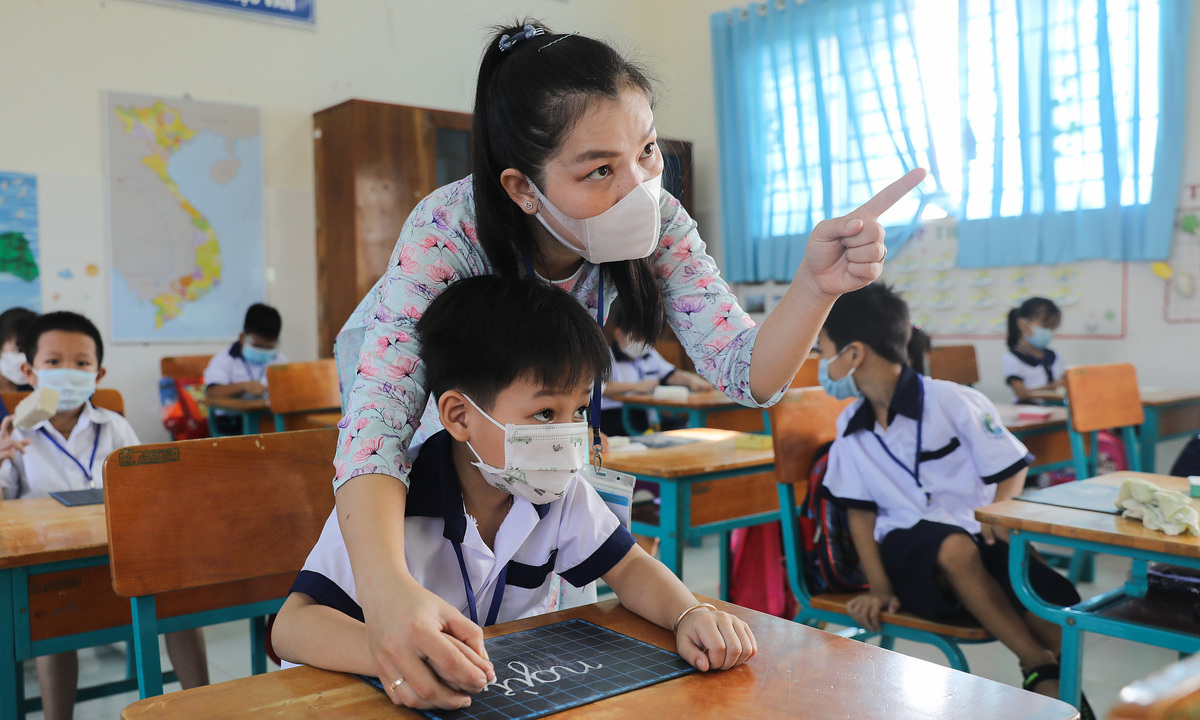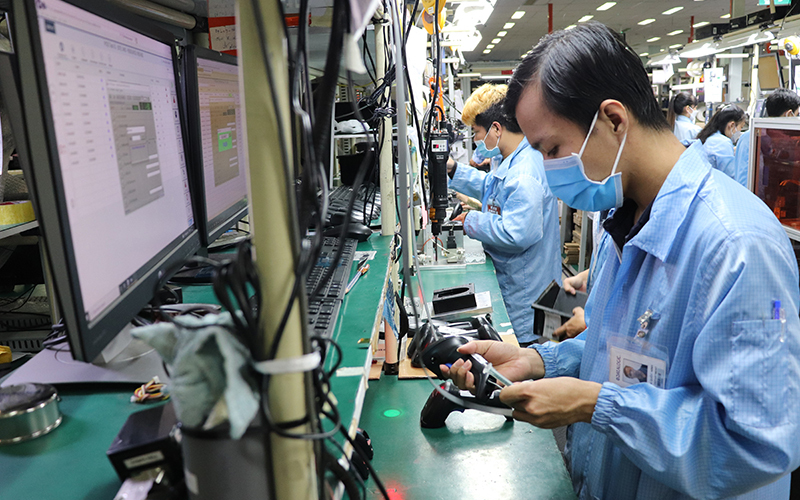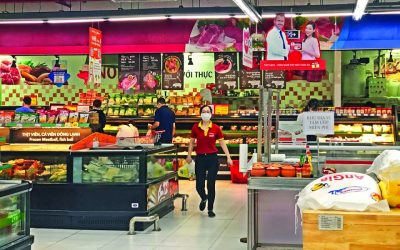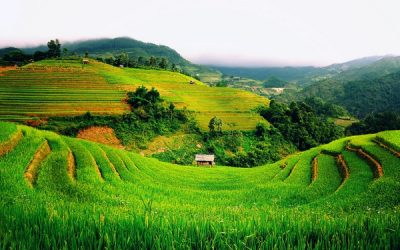Industries
DCPA provides up-to-date perspectives on most prominent industries, backed by their dynamics and Vietnam inherent strengths.
Agribusiness
Agriculture and its related sectors play an increasingly important role in Vietnam’s transition to a market-based economy …
Modern Retail
Vietnam’s retail sales have grown consistently over a long period of time, maintaining a 5-year CAGR of 15% …
ICT
Vietnam government has identified ICT as a major industry and socio-economic growth driver and is urging government agencies …
Health Supplements
Vietnam’s health supplement market is seeing a rapid growth due to the country’s demand for health-related …
F&B Service
F&B holds the highest proportion in Vietnamese spending expenditure, accounting for 35% of monthly …
Tourism
Tourism sector appears to be responding well to global economic challenges, iwth initial encouraging results …

Agribusiness
Agriculture continues to play a considerable role in Vietnam’s transition to a market-based economy, despite its shrinking portion in GDP (18.1% in 2015, compared to 16.1% in 2014). Vietnam’s strength in agricultural output is built upon a large rural base where farm and agribusiness labor accounts for 44.3% of the workforce and 65.7% of the population is located in rural areas (2015).
Besides production to satisfy [increasing] domestic demand, Vietnam is also playing its part on the agricultural import and export markets. Opportunities are abundant at all levels of the value chain as levels of production continue to improve through the application of intensive farming and advanced technologies.
Read more of our analysis below:
More on Vietnam’s Agriculture
Vietnam’s agriculture is export-focused and dominant crops include rice, coffee, rubber, and cashew. Over the past 15 years, Vietnam has significantly increased productivity in rice growing and it has become the largest rice exporter in the world. In more recent years, aquaculture and fruit production have grown substantially and are export-oriented as well. As purchasing power and consumer awareness are improving, the domestic market becomes more and more interesting. Surging domestic consumption combined with increasing demand for high value products have also pushed up imports of agricultural products into Vietnam with meat and meat products enjoying the highest growth, followed by rubber, animal feed and feed grain, sugar and cotton.
Vietnam is characterized by a certain extent of geographical specialization with specific crops concentrated in specific parts of the country such as:
- Aquaculture areas in Mekong River Delta (Southwest)
- Rice areas in Mekong River Delta and Red River Delta
- Coffee areas in Central Highlands
- Tea areas in the Northeast, Northwest and Lam Dong Province (Central Highlands)
- Rubber areas in the Southeast
- Fruit areas in the Mekong River Delta
- Cacao in the Central Highlands, Mekong River Delta
- Spices in the Central Highlands
- Dairy in the Mekong Delta, Northwest
- Pork in the Southeast (notably Dong Nai Province)
- Vegetables and Flowers in Lam Dong Province and Red River Delta
Retail
Vietnam’s retail sales have grown dramatically over a long period of time, maintaining a 5-year CARG of 17.6% (2010-2015) despite the economic slowdown in these years, to reach almost US$110bn in 2015.
In particular, modern retail is growing extremely fast, though notably in big urban areas, and is taking up an increasing portion of total retail sales. The emergence of the modern retail formats and the participation of foreign retailers have brought a breath of fresh air and greatly changed the face of retail in Vietnam, bringing more choice and convenience for consumers.
Find out more below:

More on Vietnam’s Retail Market
Although the modern retail has many advantages in attracting customers and is forecast to grow strongly in the future but in general, shopping at traditional retail market still accounts high proportion until 2015 (at least 70%). Under competitive pressure from modern retail channels, local market systems and other forms of traditional retail in Vietnam have been renewing and upgrading infrastructure as well as enhancing customer service to bring more benefits to consumers.
The role of retail flooring to retailers around the world as well as in Vietnam is obviously vital. Retail flooring has always been top a “hot” topic. The retail flooring market in Vietnam is even more difficult when not only the supply is limited but also the available ones are at high rent prices.
Since 1 Jan 2009, Vietnam has opened its doors for the retail business with 100% foreign ownership. They are authorized distributors of all products made in Vietnam and other products legally imported into Vietnam; excluding a number of long-term limits as prescribed by the Government.

Education
Education always plays a central role in Vietnamese culture and society. Vietnamese people believe that virtues are attained through learning. More parents sacrifice to ensure that their children obtain the good education. With the Vietnam’s increasing well-being, rising disposable income, young population, and the expanding emergence of high-income and middle-income classes, the demand of a higher quality education has been growing significantly. However, the public education system is heavily overloaded and far from able to meet people’s demand or expectations. Therefore the private education sector was incepted in early 1990s and has since encouraged though Government’s policies have been somewhat inconsistent. Read more below:
More on Education
Students in the state sector now bear a significant share of the cost of education that include tuition fees (most of which are subsidized by the Government), books, uniforms and school supplies yet the quality tends to worsen due to the pressures of over-capacity and student results. That’s how the private sector has expanded at a steady pace: private primary enrollment (2010: 40,378) makes up only 0.6% of total primary enrollment but has increased at 5-year (2005-2010) CAGR of 7.2% compared to negative 2.3% of the entire primary enrollment, due to narrowing child population; private secondary – both lower and upper – enrollment (2010: 970,560) accounts for over 10% of total secondary education, and is slightly contracting at a lower rate than the entire secondary enrollment (5-year CAGR of 0.1% and -2.4%, respectively), owing to, again decreasing child population.
Currently, private schools are categorized into two types: pure local, bilingual and pure international schools. Pure local private schools only do well in terms of teaching quality and financial performance at the primary level. Bilingual schools do well at the lower and upper secondary levels. Pure international schools do well at all levels from kindergarten to college, although at lower levels a large number of their students are children of expatriates or returning overseas Vietnamese.
Logistics
The logistics industry is one of the fastest growing industries in Vietnam and is estimated to grow at a pace faster than the GDP growth rate. Currently, the logistics service accounts for 15-20% of GDP in Vietnam. However the poor and small logistics infrastructure and – rapidly expanding but currently inadequate – transport infrastructure resulted in a high cost.

Logistic Industry in Vietnam
Ha Noi, Hai Phong (North), Da Nang (Central) and Ho Chi Minh City (South) are current major logistics hubs in Vietnam. There is an outsourcing trend for logistic services in Vietnam and they are classified in two groups:
- Basic services including outbound transportation/warehousing and inbound transportation/ warehousing.
- Specialized services including warehouse management, inventory management, order processing, vendor management, custom information and support, reverse logistics and climate controlled logistics.
The players on the market are divided into three groups:
- Multinational and joint venture companies (foreign-invested) : targeting global customers in Vietnam by offering logistic packages (such as 3PL package –Third Party Logistics)
- State owned companies/corporations: this group dominates local market on freight transportation and delivery
- Joint Stock and private companies, this group targets customers who are in private sector in Vietnam. Though this group consisting of small & lack of capital local companies but they have potential to develop in the future, currently many of them are competing with players in the first group to offer 3PL package to multinational customers in Vietnam.
Generally, foreign-invested companies can either set up the companies to provide logistics services in Vietnam or participate in some parts of the whole supply chain of services such as follows:
- Warehousing & distribution centers: There are opportunities in setting up warehousing infrastructure, including climate controlled warehousing systems at airports for handling of air freight, at some centers for export such as Da Nang and in the Mekong Delta. Furthermore, warehousing infrastructure should be integrated into other logistics functions such as transportation, inventory management, cold chain, customs facilities and warehouse management.
- Suppliers of software for Warehouse Management System (WMS) and Transportation Management System (TMS) due to lack of these software in most of warehouses and distribution centers in Vietnam.
- Education and training: The lack of skilled and experienced logistics personnel in Vietnam and the growing logistic sector that created a demand in this field. The industry also needs advanced and affordable logistics programs to be introduced in universities/technical schools/ vocational schools.
- Climate controlled logistics: Vietnam exports a lot of seafood, vegetables, flowers and also imports processed food products and drugs. This creates a high demand for climate controlled logistics service. Dutch companies can be suppliers of advanced climate controlled warehousing technology, value added services e.g. packaging, tagging, processing of high value seafood for export, etc. Dutch companies can also supply equipment, panels and cold-gas for cold storages and trucks.

Hi-tech
Vietnam’s fascinating economic growth since the mid-eighties, its young population (about 60% is under 35 years old), political stability and unique geographic position as gateway to Chinese and South East Asian markets have made the country an attractive investment destination and an interesting domestic market of 92 million people. Its hi-tech sector followed the economic growth of the country and nowadays many well-known hi-tech companies do have a presence in Vietnam. Nevertheless, Vietnam’s own hi-tech R&D is still at an infant stage in several sectors.
More on Technologies
The Vietnamese Government is aware of the need to change its current economic model of low labor costs, natural resources, FDI and export to a new model of added value, quality and sustainable growth. Therefore, the development of its hi-tech sector has been put high on the Government agenda. This provides interesting business opportunities for Dutch hi-tech companies due to the incentives provided (such as major tax reductions, funding and exemption from land rent) in combination with the general advantages of the Vietnamese market (low labor costs, strategic location, increasing domestic purchase power, etc.). Further global and regional integration will add to the attractiveness of Vietnam, in particular a single ASEAN market (AEC) and a Free Trade Agreement (FTA) with the EU, which is currently being negotiated.
However, there are also a number of challenges to be mentioned. Two major obstacles are the strict requirements for hi-tech projects to become eligible for government incentives and the poor human resources available. Furthermore, several other general barriers, such as poor infrastructure, bad IPR protection and software piracy, as well as sector specific barriers apply.
The report focuses on a number of specific high tech areas in Vietnam such as ICT, nano-technology and biotechnology, which are being applied in a wide variety of other sectors, including key sectors for Dutch entrepreneurs in Vietnam. These sectors include agriculture, maritime and chemical industries, transport & logistics, water and energy. Information on these key sectors and other sectors is available at the Embassy in Hanoi and Consulate General in Ho Chi Minh City.
Heath Care
The health care system in Vietnam has long been cited as an example of primary health care that worked well. Vietnam brought down the rates of infant and under-five mortality as well as child mortality rates. Maternal mortality has also fallen dramatically, as have deaths from infectious diseases.

Healthcare in Vietnam
There are, still several major challenges need to be tackled. These include the disparity in child mortality and maternal mortality rates, as well as the control of infectious diseases among marginalized groups and ethnic minorities. There are also concerns about the fight against new and re-emerging (infectious) diseases such as cholera, measles, dengue fever, HIV/Aids, Avian flu, Japanese encephalitis and SARS. In addition, like in other rapidly developing economies, non-infectious communicable diseases such as diabetes, cancer, cardiovascular diseases, cancer and mental disorders are a growing concern. Furthermore, liberalization of economic policies has encouraged private medical practice and free trade in medicines and drugs, but financial support for the state health system remains inadequate. State hospitals are overcrowded, parts of the population are not being covered by Vietnam’s state health care and private health care expenses of a large part of the Vietnamese households exceed a reasonable fraction of their incomes.
There are more than 1,000 hospitals in Vietnam, but as mentioned above, this number does not satisfy the increasing demand. Statistics from the General Statistics Office of Vietnam showed that there are just 2.71 beds for every 1,000 inhabitants, although the government set a target of 20.5 beds per 1,000. State-owned hospitals often cope with budgetary problems and cannot afford the latest equipment and treatments. The Vietnamese government would like to improve the issue and is currently drafting a new master plan up to 2020 on developing Vietnam’s health care systems.
According to the master plan on health care in Hanoi, from 2016 to 2020, 15 new hospitals will be built. In Ho Chi Minh City, 7 new hospitals with a total investment of VND 13,000 billion are being built. In other municipalities or provinces across the country, the development of health care systems also draws much attention from local government.
Next to state-owned hospitals, private-owned establishments play a significant role in increasing the capacity of hospital facilities. Following World Trade Organization (WTO) admission in 2007, Vietnam allows foreign investors to set up 100% foreign-owned hospitals. These hospitals help improve service quality and reduce the financial burden on the country’s state budget.

Pharmaceuticals
Like many of its regional neighbors, the Vietnamese pharmaceutical market is still underdeveloped and suffers from poor regulatory and intellectual property standards. Low-cost, locally produced generic drugs as well as counterfeit products accounts for a sizeable proportion of drug consumption due to low consumer purchasing power and an under-funded healthcare system.
More on Vietnam’s pharmaceuticals
Vietnamese drug makers comprise only 40% of the total medicines market while imports of raw material used in drug production represents around 90%. Heavy reliance on pharmaceutical imports makes local firms to be unable to compete with international groups.
Counterfeit drugs make up a significant amount of consumption due to the lax enforcement of legislation, which not only negatively impacts the original producers but also jeopardizes public health. The Ministry of Health of Vietnam (MoH) estimates that the country’s traditional medicine market consists of approximately 500 products, with only 50 of these being legal. Acknowledging that the high levels of fake and low-quality drugs are due to lax management, the MoH is planning to implement more drastic punishments for producers and importers found circulating such products.
Another issue is erratic pricing. Due to a lack of controls, medicine costs fluctuate wildly throughout the supply chain. A recent survey of pharmacies showed that the prices of 65 medicines made locally had increased, with some rising as much as 40% on a month-on-month. Under the new price regulation rules, violating companies and organizations will be fined heavily.
Since Vietnam’s WTO accession, more and more foreign pharmaceutical firms are operating in Vietnam. There are currently 178 domestic pharmaceutical producers active in the country. The government aims to improve the sector by increasing foreign drug trade and the number of drugs producers in the country, and improving domestic drug output in quantitative and qualitative terms.

Check out our latest updates on Vietnam’s Industries
Vietnam’s industries have taken various sustainabililty initiatives
Various industries in Vietnam have been taking sustainability initiatives and measures with a view to realializing COP26 goals and in line with the global trends and requirements.
Digital transformation reshaping the economy and its key industries
Digitalization is greatly reshaping the Vietnamese economy and its key industry sectors, typically banking, retail, logistics and manufacturing which affect hundreds of businesses and millions of people.
F&B services – a multibillion dollar market still growing fast
A multi-billion dollar market of Vietnam, yet still growing fast, mostly driven by the beer and the retail cofee and snacks shop sub-sectors, which tend to thrive despite economic slowdown. .
Vietnam Tourism – poised for strong bounceback and growth
Endowed with diverse and beautiful landscape, now with storng deternination by the Government and industry players, Vietnam tourism is poised for strong bounceback and impressive growth.
Heath supplements – a great alternative to pharmaceuticals
Driven by fast aging population, rising disposible income, and increasing awareness of health protection (prevention rather than treatment) and beauty care, health supplements sector has ample growth potential.
ICT – a fast-growing sector spurred by digitalization
ICT is among fastest-growing sectors in Vietnam, spurred by diigital transformation at both government and business levels. Demand for IT infrastructure and services has soared.
Modern retail – added dynamics from e-commerce
Maintaining strong growth momentum, with added dynamics from e-commerce. Foreign players outperform in both physical and electronic formats.
Agribusiness – new driver of Vietnam’s economic growth
Agribusiness is the new key driver of Vietnam’s economic growth, with rice, vegetables and fruits in the spotlight Value-add has been greatly enhanced and export prices improved substantially.
Key rationale behind Vietnamese rice’s success story
Vietanam has solidly maintained a top 5 rice producer and second largest rice exporter while recently emerging as the highest-valued rice marker, outperforming Thailand. ST24 and ST25 have emerged as top brands.
Vietnam Pharmaceuticals
Like many of its regional neighbors, the Vietnamese pharmaceuticals market is still underdeveloped and suffers from poor regulatory and intellectual property standards. Low-cost, locally produced...
Vietnam Healthcare
The health care system in Vietnam has long been cited as an example of primary health care that worked well. Vietnam brought down the rates of infant and under-five mortality as well as child...
Vietnam Hi-tech
Vietnam’s fascinating economic growth since the mid-eighties, its young population (60% is under 35 years old), political stability and unique geographic position as gateway to Chinese and South...
Vietnam Logistics
Logistics industry is one of the fastest growing industries in Vietnam and is estimated to grow at a pace faster than the GDP growth rate. Currently, the logistics service accounts for 15-20% of GDP...
Vietnam Retail
Vietnam’s retail sales have grown dramatically over a long period of time, maintaining a 5-year CAGR of 17.6% (2010-2015) despite the economic slowdown in these years, to reach almost US$110bn in...
Vietnam Education
Education always plays a central role in Vietnamese culture and society. Vietnamese people believe that virtues are attained through learning. More parents sacrifice to ensure that their children...
Vietnam Agribusiness
Agriculture continues to play a considerable role in Vietnam’s transition to a market-based economy, despite its shrinking portion in GDP (18.1% in 2015, compared to 16.1% in 2014). Vietnam’s...















